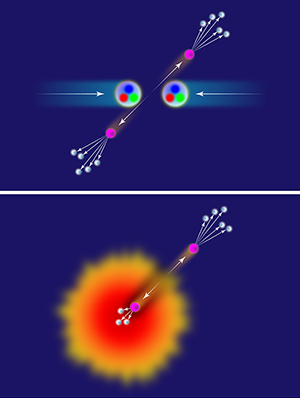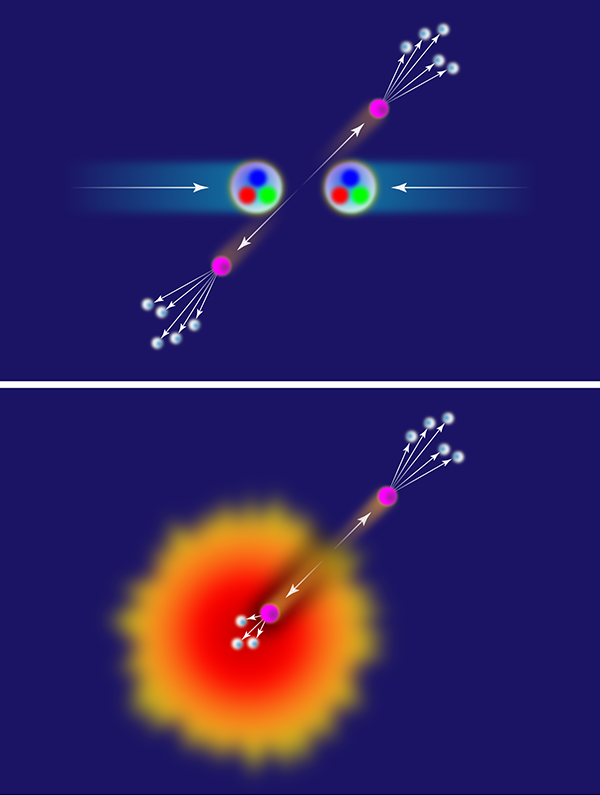The Stopping Power of Hot Nuclear Matter
When a bullet is shot into a dense substance, it is stopped after traversing a characteristic distance. By determining the stopping power of the material and analyzing how the energy of the projectile is transferred to the medium, one can gather important information on the projectile, the medium, and their interactions. Some of the most complex experiments carried out at large particle-accelerator facilities around the world do essentially the same thing: The projectiles are made of jets of hadrons (subatomic particles made of quarks and gluons) and the propagating medium is a small, extremely hot fireball, which is not much larger than the nucleus of a heavy atom and falls apart in less than seconds. This fireball, created by colliding heavy ions at high energies, goes through a phase called quark-gluon plasma (QGP) (a state of matter in which quarks and gluons are liberated from the hadrons), while the jets of hadrons are naturally formed in the initial stages of the heavy-ion collisions. The Compact Muon Solenoid (CMS) Collaboration at the Large Hadron Collider (LHC) has now studied how jets made up of hadrons containing a specific type of quarks (bottom quarks) are stopped or “quenched” in these peculiar QGP fireballs. The results—similar to those obtained in earlier experiments on jets made of lighter quarks—suggest that, under similar conditions, quenching occurs in the same way for jets of quarks with different masses [1].
Observing how jets made of different particle types are quenched in the QGP might help reveal the fundamental properties of this hard-to-probe state of matter, believed to have existed in the very early Universe mere millionths of a second after the big bang. The Universe was in a QGP phase—so hot that that the protons and neutrons that would later make up atomic nuclei were still melted in their constituents: quarks and gluons. Nowadays, the temperature and density conditions needed to reach the QGP phase of matter can be recreated in terrestrial particle accelerators [such as at CERN and at the RHIC (Relativistic Heavy Ion Collider) accelerator of the Brookhaven National Laboratory] by smashing together heavy ions, like gold or lead, at ultrarelativistic velocities, reaching temperatures several hundreds of thousand times higher than those found at the center of the Sun.
In these experiments, the heavy ions collide and their hundreds of protons and neutrons melt into a QGP fireball, which then expands and cools down. The individual quarks and gluons then recombine to form a different set of hadronic particles, such as protons, neutrons, pions, kaons, etc. The particles in this collision debris fly apart in all directions and are captured by the laboratory’s particle detectors. The collected data can then be used to infer the properties of the QGP fireball formed in the initial stages of the collision.
When two individual protons collide at high energies in vacuum, the partons that compose them (parton is the generic name given to the constituents of the nucleons: quarks and gluons) can hit each other. In some of these collisions, a large amount of energy is transferred to those partons, which fly away with high momentum from the collision axis. Later, the partons “hadronize,” i.e., they form localized, directional sprays of energetic hadrons called jets (see Fig 1, top). These processes are well understood within quantum chromodynamics (QCD), the theory describing strong nuclear interactions.
The same sort of highly energetic proton-proton collisions can be produced in the early stages of heavy-ion collisions, but in this case, the situation is more complex: many jets are produced and propagate in a dense QGP fireball (see Fig 1, bottom). Thus, as in the case of the bullet propagating in a dense medium, the jets can be stopped or almost extinguished, depending on the stopping power of the QGP. Because of momentum conservation, at least two jets are always generated, traveling in opposite directions. But often one of the two jets in the pair is extinguished. This phenomenon, called “jet quenching,” was first observed at RHIC in 2001 [2,3], and later confirmed at the LHC, through experiments exploring higher values of the transverse (relative to the beam axis) jet momentum ( ).
To describe how hot nuclear matter affects the propagation of jets, physicists measure the so-called nuclear modification factor ( ), given by the ratio of the yield of high- particles measured in nucleus-nucleus collisions over the same yield in proton-proton collisions (scaled by the appropriate number of equivalent collisions). A value of close to indicates that high- particles are not affected at all by the hot nuclear matter in the fireball. And this is indeed the value found for particles that do not directly experience strong nuclear interactions, like photons or bosons (elementary particles that mediate the weak interaction and are unaffected by the strong force). A value of smaller than 1 is instead found for other hadronic particles, such as pions or kaons, meaning that jets of these particles lose energy through their propagation in the medium. The value of is also affected by the collision geometry [4].
The effectiveness of jet quenching could also be expected to depend on the flavor (or type) and the mass of the propagating partons. had been measured previously for different sets of light hadrons consisting of light-mass quarks (up, down, or strange quarks), yielding values in the – range, depending on the values of and on the centrality of the collision. Now, the CMS Collaboration has focused on hadrons that contain a heavier bottom ( ) quark, finding, within the same range of transverse momentum , similar values. This is surprising, as a quark is roughly one thousand times heavier than an up quark. This leads the researchers to conclude that jet quenching, in the range of momenta they studied, does not have a strong dependence on the mass of the propagating parton.
How can the stopping power of the QGP fireball be the same for “bullets” with very different masses? Several theoretical models have been proposed to describe the possible energy-loss mechanisms for a parton traversing a QGP, each delivering different predictions for its mass and flavor dependence. Such models depend on the value of the QCD coupling constant (the parameter describing the strength of the nuclear force interaction) [5] and on how the QGP medium is represented.
When these sorts of experiments were planned, it was thought that weakly coupled methods would be enough to describe them. But a 2011 study [6] found that the QGP behaves as an almost perfect liquid, rather than as a gas, pointing to strongly coupled behavior. In contrast, the new result of the CMS Collaboration suggests that a small-coupling-constant model would better explain the weak mass dependence of the observed jet quenching. What all these seemingly contradictory results could imply is that QGP physics is very different for different spatial scales. At the short distances probed by jets, the data indicate that the system is weakly coupled. However, over larger scales on which many-body, collective effects develop, the QGP behaves as strongly coupled. This scale dependence could be naturally explained as a consequence of QCD’s asymptotic freedom (meaning that the strength of the interaction becomes weaker and weaker when considering processes at higher and higher energies).
Experimental results such as these reported by the CMS Collaboration [1] are exceptionally valuable given the demanding physics involved: Describing, from first principles, the many-body processes in the matter produced after heavy-ion collisions is a challenging task because of the complexity of QCD. Thus different approximations and models have to be used, and these hard-to-gather data provide us with a unique opportunity to validate or discard such models. Clearly, more experimental data and theoretical effort are still needed to tackle this complex problem, which, ultimately, is about understanding how matter behaved in the early moments of our Universe.
This research is published in Physical Review Letters.
References
- S. Chatrchyan et al. (CMS Collaboration), “Evidence of -Jet Quenching in PbPb Collisions at ,” Phys. Rev. Lett. 113, 132301 (2014)
- K. Adcox et al. (PHENIX Collaboration), “Suppression of Hadrons with Large Transverse Momentum in Central Collisions at GeV,’’ Phys. Rev. Lett. 88, 022301, (2001)
- J. Adams et al. (Star Collaboration), “Transverse-Momentum and Collision-Energy Dependence of High- Hadron Suppression in Collisions at Ultrarelativistic Energies,” Phys. Rev. Lett. 91, 172302 (2003)
- Since in a head-on collision the resulting fireball is bigger, the partons’ energy loss is much higher than in a peripheral collision, in which there are fewer initial colliding nucleons and the volume of the fireball is smaller
- D. d’Enterria “Jet quenching,” Landolt-Börnstein, New Series, Group I, Vol. 23 (Springer Verlag, Berlin, 2010); arXiv:0902.2011
- H. Song, S. A. Bass, U. Heinz, T. Hirano, and C. Shen, “200 GeV AuAu collisions serve a nearly perfect quark-gluon liquid,” Phys. Rev. Lett. 106, 192301 (2011); Erratum, 109, 139904 (2012)





